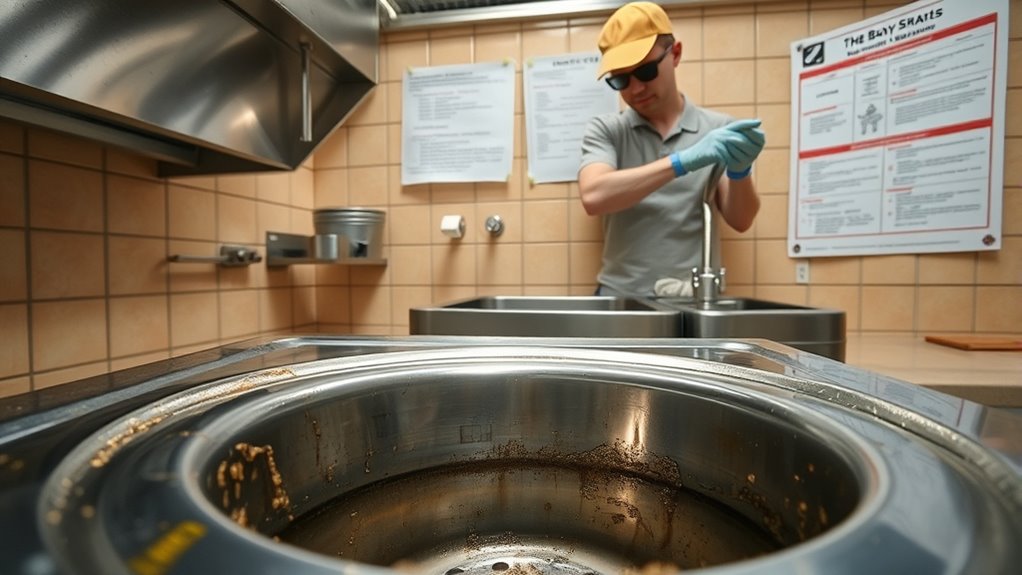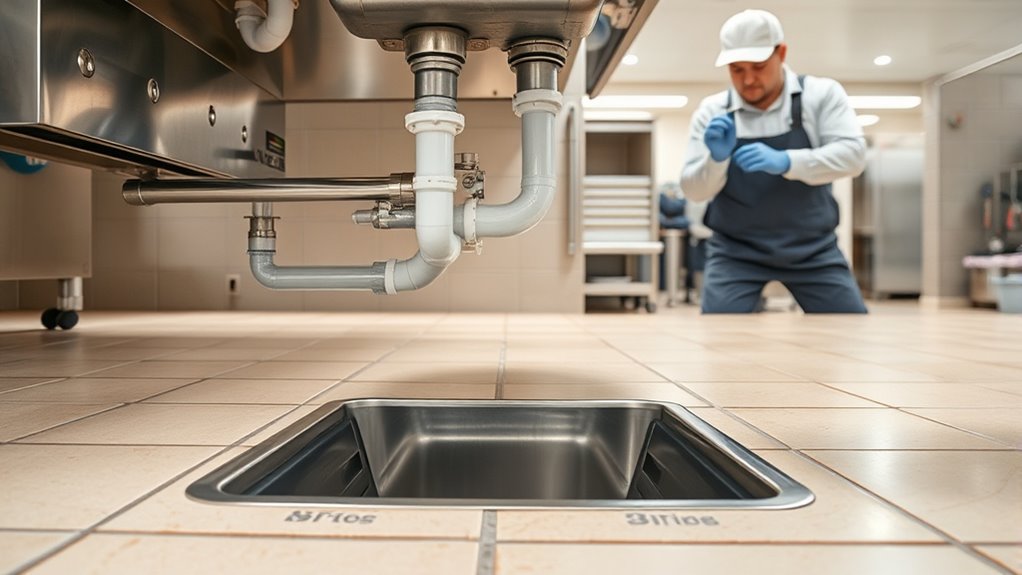To comply with grease-trap regulations and best practices, you need to understand your local and state requirements, including inspection and record-keeping protocols. Guarantee your trap is properly installed, maintained regularly, and cleaned on schedule, using appropriate disposal methods and recycling when possible. Train staff on proper waste management and monitor your system frequently to prevent issues. Staying compliant helps avoid fines and environmental harm; how to effectively manage this process is what you’ll explore next.
Key Takeaways
- Comply with local regulations by maintaining proper trap size, installation standards, and accurate record-keeping of maintenance and inspections.
- Schedule regular cleaning (every 1-3 months) and use certified disposal or recycling services for grease waste.
- Ensure proper trap installation with corrosion-resistant materials, secure fittings, and accessibility for cleaning and inspection.
- Keep detailed records of permits, inspections, cleaning activities, and repairs to demonstrate regulatory compliance.
- Train staff on proper waste disposal, trap maintenance, and emergency response protocols to prevent blockages and environmental hazards.
Understanding Local and State Regulations for Grease Traps

Understanding local and state regulations for grease traps is essential because these rules can vary considerably depending on where you operate. You need to know which agencies oversee waste management and plumbing codes in your area. Regulations might specify trap size based on your restaurant’s size or volume of grease generated. Some locations require regular inspections, maintenance, and record-keeping to ensure compliance. It’s your responsibility to stay updated on any changes in regulations, which may be detailed in local ordinances or state environmental agency guidelines. Staying informed about regulatory compliance helps prevent violations and promotes environmentally responsible waste management. By understanding and adhering to these requirements, you protect your business from legal issues and contribute to environmentally responsible waste management.
Key Components and Design Standards for Effective Grease Traps

To guarantee your grease trap functions effectively, it’s essential to focus on its key components and adhere to design standards that promote ideal separation of fats, oils, and grease (FOG). A well-designed trap includes essential parts like baffles, a inlet, outlet, and a secure lid. Proper baffle placement ensures FOG rises and separates efficiently, preventing blockages downstream. The inlet must allow smooth flow without disrupting separation, while the outlet should control water exit rate. The trap’s size and capacity should match your kitchen’s volume, preventing overflow. Materials like durable, corrosion-resistant plastics or metals enhance longevity. To optimize performance, ensure the trap is accessible for cleaning and maintenance. Regular inspections and adherence to local standards keep your system compliant and working at peak efficiency. Additionally, understanding the importance of road signs can help prevent accidents that might damage your property or infrastructure, including grease traps.
Proper Installation Procedures and Permitting Requirements

You need to guarantee proper site selection and preparation to avoid future issues. Obtaining the necessary permits and keeping detailed documentation is vital for compliance. Finally, following correct installation techniques helps ensure your grease trap functions effectively and meets all regulatory requirements. Incorporating digital literacy programs can facilitate communication and training among staff involved in installation and compliance processes.
Site Selection & Preparation
Selecting an appropriate site for a grease trap is essential to guarantee efficient operation and compliance with regulations. You need to choose a location that’s easily accessible for cleaning and maintenance, minimizing disruption to your operations. Make sure the site is close to the source of grease discharge, such as the kitchen or food prep areas. The ground should be stable and capable of supporting the trap’s weight. Proper drainage and slope are critical to prevent backups or pooling. Additionally, verify that the site meets local codes and has enough space for future expansion or servicing. Regular inspection and proper storage practices are vital to prevent spoilage or issues related to improper placement.
Permitting & Documentation
Proper installation of a grease trap requires obtaining the necessary permits and following local regulations, which help guarantee compliance and prevent potential legal issues. Before starting, check with your local health or environmental department to understand the specific permitting process. You’ll need to submit detailed plans, including site drawings and equipment specifications. Keep records of all communications and approvals to ensure documentation is complete. Use the table below to track your permit status and required documents:
| Permit Type | Documents Needed |
|---|---|
| Installation Permit | Site plans, equipment specs |
| Inspection Approval | Inspection reports |
| Maintenance Records | Service logs, receipts |
| Compliance Certifications | Certification of proper install |
| Renewal Permits | Updated plans, recent inspections |
Proper Installation Techniques
Installing a grease trap correctly starts with following the proper procedures to guarantee compliance and ideal function. First, verify you select the right size and type for your setup. Check local codes and obtain necessary permits before installation. Proper placement is vital—install the trap downstream of fixtures but before the main drain. Maintain a level, accessible position for easy servicing. Use durable, watertight fittings and ensure proper sealing. During installation, verify all connections are secure to prevent leaks. Finally, document all steps and inspections for future reference. Additionally, being aware of family photoshoot fails can help avoid mishaps during setup or inspection.
Routine Maintenance and Cleaning Schedules

Regular maintenance and cleaning are essential to guarantee your grease trap functions effectively and prevents costly backups or violations. You should establish a routine schedule based on your business size and usage, typically cleaning every 1 to 3 months. Regular inspections help you identify signs of clogging, such as slow drainage or foul odors. When cleaning, remove accumulated grease, solids, and debris using appropriate tools, and dispose of waste properly. Skipping routine cleaning can lead to grease buildup, blockages, and potential fines. Keep detailed records of each cleaning to demonstrate compliance with regulations. Consistent maintenance not only keeps your grease trap operating efficiently but also extends its lifespan, saving you money and preventing operational disruptions.
Monitoring and Record-Keeping for Compliance

To guarantee your grease trap remains compliant with regulations, monitoring and record-keeping are essential. Regularly tracking your trap’s performance helps identify issues early and ensures adherence to legal requirements. Keep detailed logs of maintenance activities, cleaning dates, and inspections. This documentation proves compliance during audits and prevents fines. Consider including:
Regular monitoring and detailed records ensure grease trap compliance and prevent costly fines.
- Dates and times of each cleaning and inspection
- Pumping and disposal records
- Visual inspection notes
- Maintenance personnel signatures
- Any issues or repairs noted
Storing these records properly, whether digitally or on paper, makes them accessible when needed. Consistent monitoring and thorough documentation keep your operation running smoothly and help you avoid costly violations. Staying organized with your records is a simple but fundamental step toward compliance. Incorporating professional-grade products can further enhance the effectiveness of your maintenance routine.
Common Violations and How to Avoid Them

Neglecting proper monitoring and record-keeping can lead to common violations that put your operation at risk. One frequent mistake is failing to maintain regular grease trap maintenance schedules, causing blockages or overflows. Another violation is improper waste disposal, such as dumping grease or solids outside approved methods, which can lead to fines. Overlooking inspection requirements or neglecting to document cleaning activities also invites penalties. To avoid these issues, stay consistent with your maintenance routines, document every service, and adhere to local regulations. Regularly review your operations to ensure compliance, and train staff to recognize signs of trap failure. Staying proactive helps prevent violations, keeps your operation running smoothly, and avoids costly fines or shutdowns. Additionally, understanding grease trap regulations can help you stay ahead of compliance requirements and prevent inadvertent violations.
Best Practices for Waste Disposal and Recycling

Properly disposing of grease prevents clogs and fines, so always follow your local regulations. Recycling cooking fats can reduce waste and support sustainable practices. Implementing these methods helps keep your operations compliant and environmentally friendly. Incorporating effective wall organization solutions with aesthetic hooks can further enhance your workspace efficiency and cleanliness.
Proper Grease Disposal Methods
Effective grease disposal is essential for maintaining compliance with regulations and protecting the environment. To do this properly, you should avoid pouring grease down drains or into regular trash. Instead, consider these best practices:
- Store used grease in sealed, leak-proof containers
- Recycle or donate excess cooking fats when possible
- Use commercial waste disposal services for large quantities
- Allow grease to cool before handling and disposing of
- Label containers clearly for safe collection
- Consider organic waste management methods to enhance eco-friendly disposal.
Following these methods helps prevent plumbing blockages, reduces environmental harm, and keeps your operations compliant. Proper disposal not only saves you money on repairs but also demonstrates environmental responsibility. Remember, responsible grease management is a critical part of maintaining a clean, compliant, and sustainable kitchen.
Recycling Cooking Fats
Recycling cooking fats is an essential step in responsible waste management that benefits both your operation and the environment. Properly recycling fats prevents plumbing issues and supports sustainable practices. To do this effectively, find a certified fat recycling service. They will typically provide containers and handle collection, ensuring fats are processed properly. Use the table below to understand common fats suitable for recycling:
| Fat Type | Collection Method | Recycling Destination |
|---|---|---|
| Animal fats | Sealed, leak-proof containers | Biofuel production |
| Vegetable fats | Properly stored in designated bins | Rendering facilities |
| Used oils | Recycled through licensed services | Waste-to-energy plants |
Additionally, understanding the importance of emotional well-being and maintaining a positive mindset can enhance your overall approach to sustainable waste practices.
Training Staff for Proper Grease Management

Training staff on proper grease management is essential to maintaining an efficient and compliant grease trap system. When your team understands how to handle fats, oils, and greases correctly, it reduces clogs, odors, and costly fines. Well-trained staff can identify issues early and prevent violations. Focus on teaching the following key practices:
- Properly scraping and wiping cookware before washing
- Using strainers to catch grease and food debris
- Regularly inspecting and maintaining grease traps
- Recognizing signs of trap overload or failure
- Understanding local regulations and reporting requirements
Emerging Technologies and Innovations in Grease Trap Management

New technologies are transforming how you manage grease traps, making maintenance more efficient and effective. Smart monitoring systems can alert you when traps need attention, while automated cleaning solutions reduce manual labor. Advances in bioremediation also offer eco-friendly options for controlling grease buildup.
Smart Monitoring Systems
Have you ever wondered how technology is transforming grease-trap management? Smart monitoring systems make it easier to track trap performance in real time, helping you stay compliant and avoid costly overflows. These systems use sensors to measure grease levels, flow rates, and waste accumulation, sending alerts when maintenance is needed. Benefits include:
- Continuous, accurate data collection
- Immediate notifications for potential issues
- Reduced manual inspections and guesswork
- Improved regulatory compliance
- Extended trap lifespan through timely maintenance
Automated Cleaning Solutions
Building on the advancements in smart monitoring, automated cleaning solutions are now emerging as a game-changer in grease trap management. These systems reduce manual labor and improve efficiency by automatically removing accumulated grease and solids. You install sensors that detect when cleaning is needed, triggering the system to activate without oversight. Some solutions feature robotic arms or suction devices that efficiently clean the trap’s interior. This technology minimizes odors, prevents blockages, and helps you stay compliant with regulations. Automated cleaning also reduces the risk of over-cleaning or under-cleaning, ensuring ideal trap performance. As these systems become more affordable and sophisticated, they offer a reliable, hands-free approach to maintaining grease traps, saving you time, labor costs, and potential penalties.
Bioremediation Advances
As bioremediation techniques continue to evolve, they’re offering innovative solutions for grease trap management by harnessing natural biological processes. These advances use microorganisms to break down fats, oils, and grease more efficiently, reducing the need for chemical cleaners and manual cleaning. Emerging technologies include bioaugmentation, where specific bacteria are introduced to accelerate grease digestion; enzymatic treatments that speed up fat breakdown; and biofilters that continually treat trap contents. You might also see the use of biodegradable additives that support microbial activity, or sensor systems that monitor grease levels in real-time. These innovations help you maintain compliance, lower costs, and minimize environmental impact. Staying ahead with bioremediation advances ensures your grease trap management remains effective, sustainable, and compliant with evolving regulations.
Strategies for Emergency Response and Troubleshooting

When a grease trap malfunctions or becomes overwhelmed, quick and effective response is essential to prevent costly backups and environmental hazards. First, shut off the flow of wastewater to prevent further buildup. Inspect the trap for signs of clogging or damage, and identify the source of the problem. Use appropriate tools to clear blockages or remove excess grease, ensuring safety precautions are followed. Keep a troubleshooting checklist on hand to guide your actions quickly. Regularly monitor trap levels and flow rates to catch issues early. If the problem persists, contact a professional for a thorough cleaning or repairs. Document all incidents and responses to improve future emergency protocols. Staying prepared minimizes downtime and reduces environmental risks associated with grease trap failures.
Frequently Asked Questions
How Do Grease-Trap Regulations Differ Between Urban and Rural Areas?
You might notice that regulations for grease traps vary depending on whether you’re in an urban or rural area. Urban locations often have stricter rules to manage higher waste volumes and prevent sewer blockages, while rural areas might have more relaxed standards due to lower population densities. You should check local codes to guarantee compliance, as enforcement and requirements can differ markedly, affecting how you install and maintain your grease trap.
Are There Specific Safety Standards for Grease Trap Installation?
Think of safety standards as the backbone supporting your grease trap installation. You need to follow specific codes that guarantee everything is secure and functional, like sturdy beams in a building. These standards often include proper materials, secure mounting, and appropriate venting to prevent hazards. By adhering to these safety standards, you protect your staff, your property, and the environment from potential issues caused by improper installation.
What Are the Penalties for Non-Compliance With Grease-Trap Laws?
You want to know the penalties for not following grease-trap laws. When you fail to comply, authorities can issue fines that range from hundreds to thousands of dollars, depending on the severity and frequency of violations. In some cases, you might face legal action, equipment shutdowns, or even closure of your business. Non-compliance also risks environmental damage, which can lead to more severe legal consequences and increased costs.
How Can Businesses Financially Plan for Ongoing Grease Trap Maintenance?
To financially plan for ongoing grease trap maintenance, you should budget regularly for inspections, cleaning, and repairs. Set aside a maintenance fund based on your expected costs, and consider scheduling routine check-ups to avoid costly emergencies. You’ll also want to stay informed about local service rates and potential upgrades. By proactively managing your expenses, you guarantee your grease trap remains compliant and avoids fines or shutdowns.
Are There Industry Certifications for Professionals Managing Grease Traps?
You might be surprised to learn that industry certifications for grease trap management do exist, giving you confidence in your service providers. Certifications like the National Association of Wastewater Technicians (NAWT) or the Certified Environmental Technician (CET) guarantee professionals are trained and knowledgeable. When you choose certified experts, you not only protect your business but also enjoy peace of mind knowing your grease trap is in capable hands, preventing costly issues down the road.
Conclusion
Staying compliant with grease-trap regulations and adopting best practices keeps your operations running smoothly. Regular maintenance, proper training, and embracing new technologies can save you time and money, while preventing costly issues. Remember, an ounce of prevention is worth a pound of cure—stay proactive, keep detailed records, and never cut corners. By doing so, you’ll protect your business, the environment, and your reputation in the long run.









